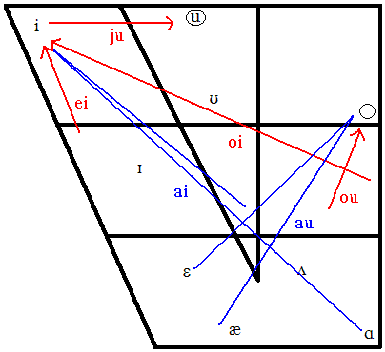
Is Canadian Raising becoming Phonemic?
The short answer is, I think so!
Canadian Raising is a phenomenon which affects the vowels /au/ and /ai/. Typically, the onset of these vowels is quite low: [au] and [ɑi] respectively. But if one of these vowels occurs before a voiceless consonant, the onset is raised to [ɛu] and [əi]. Words like ‘Eyes’ and ‘Ice’ have significantly differenty vowel sounds, qualitatively: [ɑiz] and [əis].
The above rule holds true. Before any voiceless consonant, the vowel is raised. This rule must precede the rule which states that /d/ and /t/ become [ɾ] after a stressed vowel. Thus, ‹writer› and ‹rider› are pronounced differently, [ɹǝ͡iɾɹ̩] and [ɹa͡iɾɹ̩] respectively, even though the resulting [ɾ] is voiced.
Things get interesting with words like ‘spider’. We would expect [spɑiɾɹ̩] with the [ɑi] allophone because the [ɾ] originated from a /d/. However, many people, including myself, pronounce this word [spəiɾɹ̩]. In casual speech, ‘Dispite her’ and ‘This spider’ are identical. Other words with anomolous raising are ‘tiger’ [təigɹ̩] and ‘fire’ [fəi͡ɹ].
The great majority of words follow the cannonical Canadian raising rule, but it seems like a couple of new vowels are on there way in. I’d like to thank the contributors of this forum page for pointing this out to me.
The values of [ɑi]~[əi] are pretty much identical across central and western Canada. However, there are significant differences between realisations of /au/.
- In most phonetic literature, the raised value of /au/ is [əu] or [ʌu], as in ‘house’ [hʌus]. This pronunciation is current throughout the prairies and the north: Alberta, Saskatchewan, Manitoba, Northern Ontario, inland British Columbia, and the Territories. Older or more rural speakers in Southern Ontario and Quebec will also typically use [ʌu].
- In Southern Ontario, Quebec, and British Columbia, /au/ has been fronted to [ɛu]. This is pervasive among younger people living in urban areas. It seems to be spreading from the cities to outlying areas. I have heard pronunciations for ‘out’ reaching as high as [eut] or [ɩut] from some speakers.
- Some Southern Ontario speakers do not include /au/ in Canadian raising, showing [au] for both ‘lout’ and ‘loud’ (although a difference in vowel length is retained). Although this was the realisation of /au/ I grew up speaking, many in my generation (including myself) seemed to make the switch to [ɛu] during our late teens.
Notes
- The phonetic symbols represent those typically used in English phonology. The location of the symbols indicates the pronunciation. RP refers to Received Pronunciation, the somewhat artificial dialect of English which comes closest to a standard in England.
- The circle around /u/ means it is rounded, as is the target for /ou/ and /au/. All other sounds are unrounded. Very often, the /u/ is only slightly rounded, or not rounded at all. In coastal British Columbia especially, /u/ can be centralised [ÿ].
- I have included the diphthong /ju/ as a separate vowel sound instead of /j/ + /u/.
- The red lines are diphthongs heading in the direction of the arrow. In closed syllables, /ei/ and /ou/ tend to be monophthongal [e] and [o].
- Blue lines show the diphthongs /ai/ and /au/ with two starting points. The higher starting point version is used before voiceless consonants: Canadian Raising.
- /æ/ is [ɛ̃] before /n/ and /m/, [ẽ] before [ŋ]. /au/ is [ɛ̃u] before /n/. /ɩ/ is [ĩ] before /ŋ/ and [i] at the end of a word.
- This dialect neutralises many vowel distinctions before /r/, so that there are no
vowel + /r/ combinations that are not diphthongs. RP English “orange” [ɒɹɩnʤ] is [ɔ͡ɹɩnʤ];
or RP “merry” [mɛɹɩ], “marry” [mæɹɩ],
“Mary” [mɛəɹɩ] are all [me͡ɹi] in this
dialect. The following /r/ based diphthongs exist.
- [ɑ͡ɹ], [e͡ɹ], [i͡ɹ], [ɑi͡ɹ], [ɔ͡ɹ], [ʉ͡ɹ], [j͡ɹ̩], [æ͡uɹ], and [ɹ̩]. As in car, care, fear, fire, for, poor, pure, power, and purr.
- [ɫ̩], like [ɹ̩] also behaves as a vowel.
- Vowels are generally short before voiceless consonants, and long before voiced consonants. Reduced vowels become /ǝ/, which can be variously realised as /ɩ/, /ʌ/, or /ǝ/